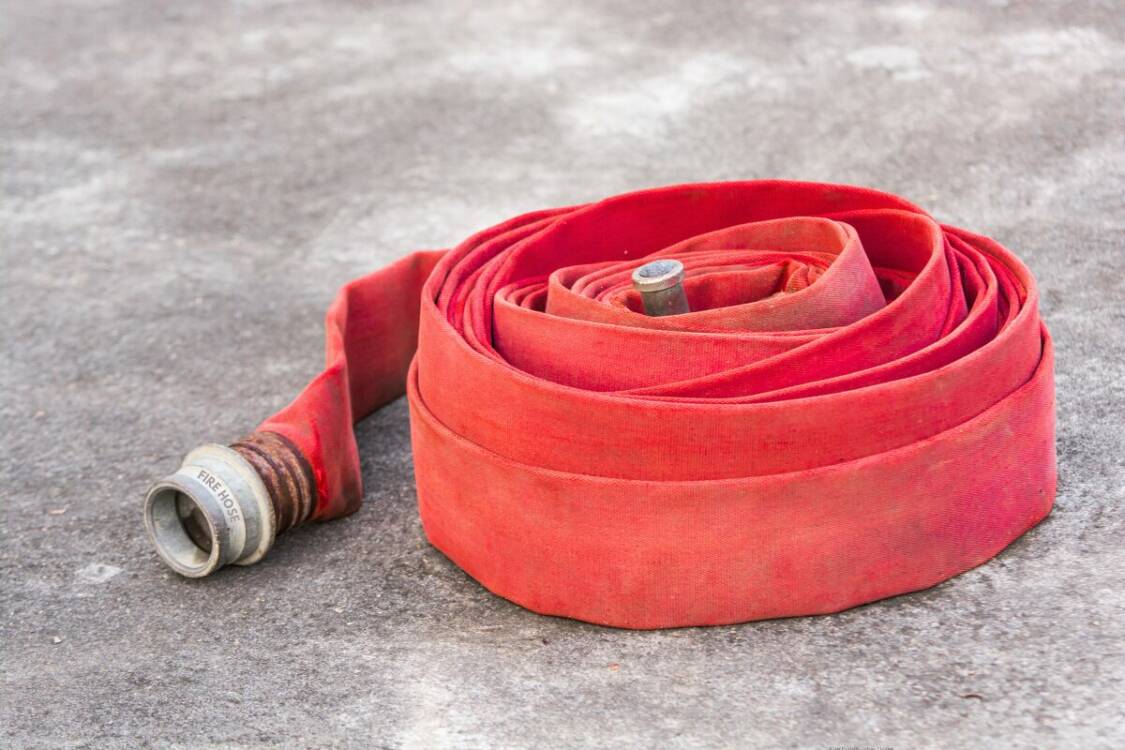A brief overview of the basics of fire hoses – what they are, why they matter, and how they are used in fire safety.
Appropriate, functional equipment is what allows firefighters and other safety professionals to act quickly, work effectively, and provide safety during emergencies. There are all kinds of equipment related to fire safety, but today we are focusing on fire hoses.
Fire hoses are a prominent tool in firefighting and emergency response. Though often overlooked, these pieces of equipment are essential for fire suppression efforts in commercial buildings, industrial facilities, residential properties, and public spaces. Whether operated by fire departments or available on-site for immediate use, hoses are key to reducing damage and protecting lives during a fire emergency.
In this article we will discuss what fire hoses are, their purpose, and the role they play in combating fire emergencies.
What Is a Fire Hose?
A fire hose is a high-pressure hose that is designed to deliver large volumes of water or other fire-suppressing agents to the source of a fire.
Generally, these hoses are used in situations with extreme heat, pressure, or abrasion. As a result, they are typically constructed from durable materials such as rubber or synthetic fabrics. Additionally, they come in various sizes, lengths, and types to accommodate the various applications and environments they might be used in.
There are two primary categories of fire hoses:
- Attack hoses – Used by firefighters to directly combat fires. These are designed for high-pressure delivery of water from a pump or hydrant.
- Supply hoses – Used to transport large volumes of water from a source (like a hydrant) to a fire engine or portable pump.
While less common, you can also sometimes find fire hoses in commercial buildings and some industrial sites. These are used in these locations to provide building occupants or maintenance teams with immediate access to water in case of a fire.

The Purpose of Fire Hoses
The primary purpose of a fire hose is to aid in controlling or extinguishing fires by providing a continuous and forceful stream of water (or other agent).
Quick and reliable water delivery is essential for:
- Reducing and suppressing flames
- Preventing the spread of fire (fire containment)
- Protecting escape routes
- Cooling hot surfaces or equipment
- Protecting nearby individuals (firefighters and occupants) from heat exposure
When used properly, fire hoses significantly reduce the time it takes to contain a fire and limit the damage that can be done.
The Role of Fire Hoses in Safety
Fire hoses are a critical tool for firefighters, safety technicians, and inspectors alike. As such, they should be considered in any facility’s fire protection plan. Here are a few reasons why:
- First Line of Defense: Some buildings include internal hose systems that can be activated and used by trained personnel to begin fire suppression efforts before the fire department arrives. This can help with controlling the fire in its early stages and limiting growth.
- Fire Department Operations: For professional firefighters, fire hoses are indispensable. These public service workers rely on fire hoses to attack blazes from multiple angles, access difficult areas, and manage large-scale fires.
- Integration with Other Systems: Hoses are often used in conjunction with fire hydrants, sprinkler systems, pumps, and fire department connections (FDCs). These systems work together to create a more effective approach to fire suppression.
- Safety Compliance: Properly installed and maintained fire hoses help facilities meet compliance and insurance requirements. Regular inspection and testing ensure that hoses are functional when they’re needed most.

Using Software for Fire Hose Maintenance
Does your job include inspections, testing, and maintenance for fire hoses? If so, we recommend exploring inspection software. Software solutions, such as InspectNTrack, are designed to make it easier to manage a fire and life safety program. Our software can be used to effectively keep and inventory of all fire hoses including size and length,and manage recurring testing and inspections
There are a wide range of options for software on the market; however, InspectNTrack software is the best. It has been developed and refined over the last 30 years to help you inspect all of your safety equipment, including fire hoses.
InspectNTrack Software can help by:
- Automating inspection scheduling
- Tracking testing history
- Generating compliance reports for audits and internal reviews
- Enabling mobile inspections for efficient on-site assessments
- Ensuring nothing is overlooked with corrective action reminders
- And so much more!
Features like these help our customers feel peace of mind about their compliance status, get excited about increased efficiency in their operations, and enjoy a more simple, streamlined version of their job.
Want to learn more about what InspectNTrack software can do for you? Click the link to set up a brief demo. Start on your journey of improved safety today.
Conclusion
Fire hoses are an essential tool for fighting fires. They help supply large quantities of water, which can be crucial for extinguishing flames and putting out large fires. While they are most commonly used by firefighters, fire hoses are also an asset that can be employed in fire protection systems at schools, hospitals, and all kinds of public buildings. To ensure that this equipment is ready for use, organizations should make it a priority to regularly inspect, maintain, and test their fire hoses.

